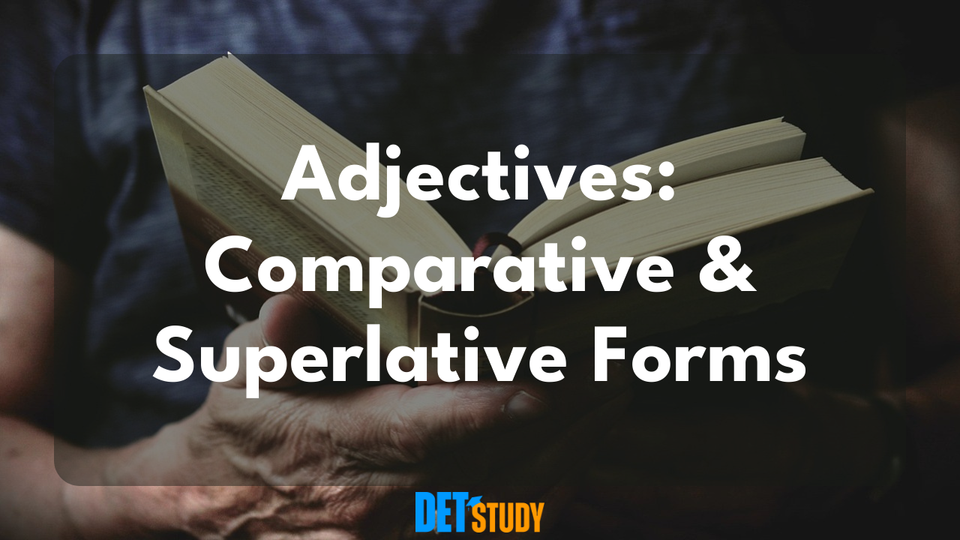तुलनात्मक र उत्कृष्ट विशेषणहरूमा निपुणता हासिल गर्नुहोस्: सहजै आफ्नो अंग्रेजी शब्दभण्डारको स्तर बढाउनुहोस्।

विशेषणहरू बुझ्नुहोस्: आधारभूत कुराहरू र महत्त्व
विशेषणहरू बुझ्नुहोस्: आधारभूत कुराहरू र महत्त्व
विशेषणहरूले नाम (Noun) लाई वर्णन वा परिमार्जन गर्छन्, जसले विवरण थप्छ र भाषालाई थप जीवन्त बनाउँछ। 🎨 तिनीहरूको प्रयोग, विशेषगरी Comparative र Superlative रूपहरूमा निपुणता हासिल गर्दा तपाईंको अंग्रेजी सञ्चारमा धेरै सुधार आउनेछ।
यी रूपहरूले नामहरू बीचका गुणहरूलाई तुलना गर्छन्:
5 Tips for the Read Then Speak Question: Duolingo English TestComparative Forms (दुई कुराहरूको तुलना)
Comparatives प्रायः '-er' मा समाप्त हुन्छन् वा विशेषणभन्दा पहिले 'more' प्रयोग गर्छन्। उदाहरणहरू:
- Tall: Taller ("Jenny is taller than Mark.")
- Happy: Happier ("She is happier today.")
- Beautiful: More beautiful ("The garden is more beautiful in spring.")
दुई वा सोभन्दा बढी Syllable भएका तर '-y' मा समाप्त नहुने विशेषणहरूको लागि 'more' प्रयोग गर्नुहोस्।
Superlative Forms (तीन वा सोभन्दा बढी कुराहरूको तुलना)
Superlatives ले उच्चतम डिग्रीलाई सङ्केत गर्छन्, प्रायः '-est' मा समाप्त हुन्छन् वा विशेषणभन्दा पहिले 'most' प्रयोग गर्छन्। उदाहरणहरू:
- Fast: Fastest ("Usain Bolt is the fastest runner.")
- Intelligent: Most intelligent ("She is the most intelligent student.")
- Funny: Funniest ("He told the funniest joke.")
दुई वा सोभन्दा बढी Syllable भएका विशेषणहरूको लागि 'most' प्रयोग गर्नुहोस्, जबसम्म तिनीहरू '-y' मा समाप्त हुँदैनन्।
Irregular Adjectives (कण्ठ गर्नुपर्ने) ✨
केही विशेषणहरूका अद्वितीय Comparative र Superlative रूपहरू हुन्छन् जसले मानक नियमहरू पालना गर्दैनन्। यी अपवादहरू चिन्नु सटीक सञ्चारका लागि महत्त्वपूर्ण छ:
- Good: Better, Best ("This is a better solution." "This book is the best I've read.")
- Bad: Worse, Worst ("His performance was worse." "That was the worst experience.")
- Far: Farther/Further, Farthest/Furthest ("She walked farther." "This is the farthest city." "We need further discussion.")
- Little: Less, Least ("She has less money." "This is the least expensive option.")
- Much/Many: More, Most ("More people are here." "That was the most interesting book.")
- Old: Older/Elder, Oldest/Eldest ("My sister is older." "He is the eldest member." Note: "Elder/eldest" often refer to people, especially family.)
यी रूपहरू कण्ठ गर्नुहोस्, किनकि तिनीहरू सूक्ष्म अंग्रेजीका लागि महत्त्वपूर्ण छन्। 'farther' (भौतिक दूरी) बनाम 'further' (अमूर्त अवधारणाहरू) लाई सन्दर्भले प्रभाव पार्न सक्छ।
Comparative र Superlative Adjectives बनाउने: नियमहरू
यी विशेषणहरू बनाउनु तिनीहरूको संरचनामा निर्भर गर्दछ। यहाँ सम्झनुपर्ने मुख्य नियमहरू छन्: 👇
१. एक Syllable भएका विशेषणहरू
Comparative का लागि -er र Superlative का लागि -est थप्नुहोस्।
- Cold: Colder, Coldest ("Today is colder." "January was the coldest month.")
- Tall: Taller, Tallest ("She is taller." "He is the tallest person.")
यदि एक Syllable भएको विशेषण एकै स्वरले (CVC pattern) पछ्याइएको एकै व्यञ्जनमा समाप्त हुन्छ भने, -er वा -est थप्नुअघि अन्तिम व्यञ्जनलाई दोब्बर गर्नुहोस्।
- Big: Bigger, Biggest ("This apple is bigger." "That is the biggest tree.")
- Hot: Hotter, Hottest ("The soup is hotter." "July is the hottest month.")
२. '-y' मा समाप्त हुने विशेषणहरू
-y मा समाप्त हुने दुई Syllable भएका विशेषणहरूको लागि, -y लाई -i मा परिवर्तन गर्नुहोस् र -er वा -est थप्नुहोस्।
- Happy: Happier, Happiest ("She felt happier." "That was the happiest day.")
- Easy: Easier, Easiest ("This test is easier." "That was the easiest question.")
३. दुई Syllable वा सोभन्दा बढी Syllable भएका विशेषणहरू ('-y' मा समाप्त नहुने)
Comparative का लागि 'more' र Superlative का लागि 'most' प्रयोग गर्नुहोस्।
- Beautiful: More beautiful, Most beautiful ("This painting is more beautiful." "That is the most beautiful flower.")
- Difficult: More difficult, Most difficult ("This puzzle is more difficult." "This was the most difficult decision.")
केही दुई Syllable भएका विशेषणहरू, जस्तै "narrow" वा "clever", ले -er/-est वा more/most दुवै प्रयोग गर्न सक्छन्। उदाहरणका लागि, Narrow: Narrower/More narrow, Narrowest/Most narrow।
How to Spot Real and Fake Words on the Duolingo English Test: Best Tips for Success४. '-e' मा समाप्त हुने विशेषणहरू
Comparative का लागि मात्र -r र Superlative का लागि -st थप्नुहोस्।
- Large: Larger, Largest ("Her house is larger." "This is the largest cake.")
- Simple: Simpler, Simplest ("Instructions need to be simpler." "She provided the simplest explanation.")

लेखनमा Comparative र Superlative Adjectives प्रयोग गर्ने सुझावहरू ✍️
स्पष्ट र सही लेखनका लागि यी दिशानिर्देशहरू पालना गर्नुहोस्:
-
आधारभूत कुराहरू बुझ्नुहोस्: - दुई वस्तुका लागि Comparatives प्रयोग गर्नुहोस्: "Tom is taller than Jerry." - तीन वा सोभन्दा बढीका लागि Superlatives प्रयोग गर्नुहोस्: "Alice is the tallest in the class।"
-
नियमित रूपहरूको पुनरावलोकन: - एक Syllable भएका: -er/-est थप्नुहोस् (Tall: Taller, Tallest)। - -y मा समाप्त हुने: y लाई i मा परिवर्तन गर्नुहोस्, -er/-est थप्नुहोस् (Happy: Happier, Happiest)।
-
"More" र "Most": - धेरैजसो दुई Syllable वा सोभन्दा बढी Syllable भएका विशेषणहरूका लागि: 'more' (Comparative) र 'most' (Superlative) प्रयोग गर्नुहोस्। (Beautiful: More beautiful, Most beautiful)।
-
दोहोरो प्रयोगबाट बच्नुहोस्: - कहिले पनि दोहोरो Comparatives वा Superlatives प्रयोग नगर्नुहोस् (उदाहरणका लागि, "more taller" वा "most tallest")। तिनीहरू गलत छन्।🚫
-
Irregular हरू कण्ठ गर्नुहोस्: - Irregular रूपहरू (Good: Better, Best; Bad: Worse, Worst) कण्ठ गर्नुपर्छ।
-
सन्दर्भ र स्पष्टता: - तुलना गरिएका विषयहरू स्पष्ट छन् भनी सुनिश्चित गर्नुहोस्। वस्तुहरूको सङ्ख्या र वाक्यको तार्किक अर्थका आधारमा Comparative वा Superlative छनौट गर्नुहोस्।
-
सही तुलनाहरू: - दुई वस्तुका लागि Comparatives प्रयोग गर्नुहोस्, Superlatives होइन। "Jan is the tallest of the two" होइन, "Jan is taller than Chris" भन्नुहोस्।
यी सुझावहरू लागू गर्दा तपाईंको लेखनमा सुधार आउनेछ, जसले थप सटीक र जीवन्त तुलना गर्न मद्दत गर्नेछ। ✨
DET Study ले तपाईंको व्याकरण, विशेषगरी विशेषण र क्रियाविशेषणहरूलाई बलियो बनाउन १५,००० भन्दा बढी अभ्यास प्रश्नहरू प्रदान गर्दछ। Duolingo English Test का लागि आत्मविश्वास र शुद्धताका साथ तयारी गर्नुहोस् र आफ्नो इच्छित स्कोरहरू प्राप्त गर्नुहोस्। 🚀
🎯 थप अभ्यास चाहिन्छ? विशेषज्ञ स्रोतहरू, १५,०००+ अभ्यास प्रश्नहरू, र AI-संचालित प्रतिक्रियाका लागि DETStudy.com हेर्नुहोस्।

